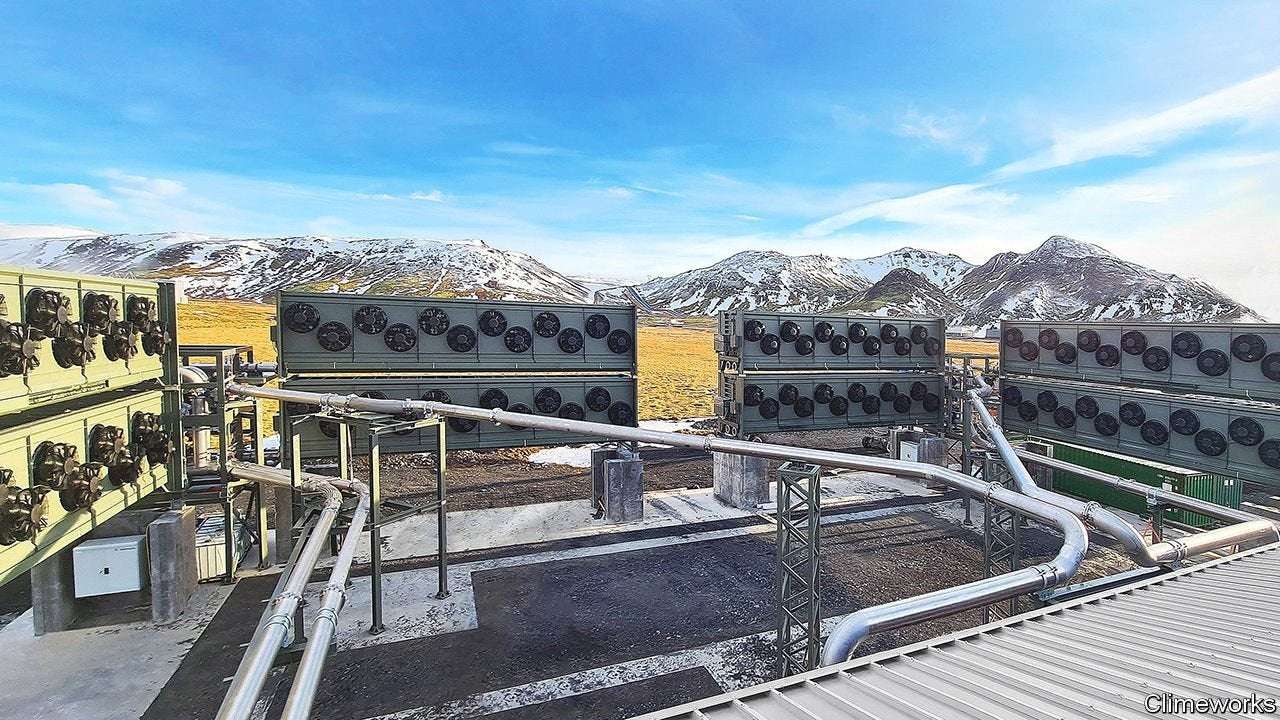SHORTLY AFTER 6pm on September 9th, the Orca carbon capture plant, just outside Reykjavik in Iceland, switched on its fans and began sucking carbon dioxide from the air. The sound was subtle—a bit like a gurgling stream. But the plant’s creators hope it will mark a big shift in humanity’s interaction with the climate.
Orca is, for now, the largest installation in the infant “direct air capture” industry, which aims to remove CO2 from the atmosphere. When sealed underground such CO2 counts as “negative emissions”—an essential but underdeveloped method for tackling global warming. To stop temperatures rising by 1.5°C or even 2°C above pre-industrial averages, as per the Paris climate agreement, hundreds or thousands of billions of tonnes of CO2 will have to be removed from the atmosphere in the second half of the century.
Currently, the only means of doing that is planting trees, an option that is not entirely without drawbacks. Trees burn in wildfires and can be cut down. When this happens, much of the carbon they store escapes. The Orca plant shows another way. Climeworks, the company that owns it, has developed chemical filters which snag CO2 when air passes through them. When heated they release the CO2 again, generating a stream of gas that is handed to another firm called Carbfix.
Carbfix pipes the gas to nearby wells, mixes it with water and pumps the resulting carbonated water into the bedrock. In Iceland that consists almost entirely of volcanic basalts, which contain minerals that react with carbon dioxide to form calcium carbonate, a white crystal that is the main ingredient in limestone. Thus, the full operation extracts CO2 from air and turns it to rock. Trials have shown that Icelandic basalts can sequester CO2 in solid rock within two years. Power comes from a nearby geothermal power station.
One catch is volume. Orca will capture 4,000 tonnes of carbon dioxide year, out of around 35bn produced by burning fossil fuels. Climeworks’s founders are “confident” they can reach millions of tonnes before the decade is out. (A previous, eye-popping ambition to grab 1% of emissions by 2025 is no longer on the cards.)
Another is cost. It costs Orca somewhere between $600-800 to sequester one tonne of carbon dioxide, and the firm sells offset packages online for around $1,200 per tonne. The company thinks it can cut costs ten-fold through economies of scale. But there appears to be no shortage of customers willing to pay the current, elevated price. Even as Orca’s fans revved up, roughly two-thirds of its lifetime offering of carbon removals had already been sold. Clients include corporations seeking to offset a portion of their emissions, such Microsoft, Swiss Re (and The Economist), as well as more than 8,000 private individuals.
Climeworks is not alone in having spotted the opportunity. Using different chemistry, Carbon Engineering, a Canadian company, is gearing up to switch on its own carbon-scrubbing facilities. It will take more than these pioneer engineers and financiers to build a gigatonne-sized industry. But the fans are turning.
For more coverage of climate change, register for The Climate Issue, our fortnightly newsletter, or visit our climate-change hub

Ear_Enthusiast on September 27th, 2021 at 12:43 UTC »
This is a science that's going to get cheaper and more and more efficient. It's still very developmental. Hopefully we can start taxing the major corporations to pay to get more of these plants up and running.
Zesky665 on September 27th, 2021 at 10:52 UTC »
These could maybe be used to soak up excess power create by renewables on peak hours. Not a silver bullet, but a neat piece of tech to have regardless.
Germanofthebored on September 27th, 2021 at 10:15 UTC »
One thing this plant is good for is to put an actual price on carbon emissions. Now that we have an idea what it costs to remove one ton of carbon from the atmosphere ($100 or so, the linked article is behind a paywall), we should tax/charge emitters accordingly. But yes, cost&capacity make me want to cry, otherwise